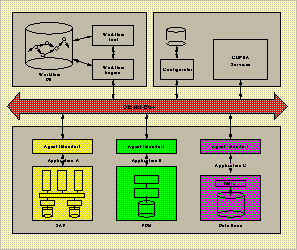The IT infrastructure of most corporations is characterized by the simultaneous use of many specialized application systems. In a manufacturing company for example, production planning systems, computer aided design and product data management systems coexist with business applications. This situation can very often not be avoided, since one must rely on the special functionality of those applications. At the same time, this means that processes and data are distributed over multiple proprietary applications. Furthermore, because of overlapping functionality of those systems, data has often to be replicated.

The IT infrastructure of most corporations is characterized by the simultaneous use of many specialized application systems. In a manufacturing company for example, production planning systems, computer aided design and product data management systems coexist with business applications. This situation can very often not be avoided, since one must rely on the special functionality of those applications. At the same time, this means that processes and data are distributed over multiple proprietary applications. Furthermore, because of overlapping functionality of those systems, data has often to be replicated.
To coordinate the development processes in a distributed corporation and to guarantee availability and consistency, the complete federation of all application systems must be achieved. In the industrial praxis, engineering database systems (EDB) have reached wide acceptance for this purpose and play an important role in CIM concepts.
In this project, we employ federated database technology to achieve global coordination of heterogeneous, autonomous and distributed engineering management systems allowing to guarantee integrity constraints over multiple applications and to manage the flow of engineering objects in production.
We pursue an approach based on the architecture shown in the picture at the right. Existing application systems, like for example SAP R/3 or PDM systems, are monitored by agents sitting atop of them. These monitors have to detect activities of the underlying applications that are of global interest. In particular, updates are recognized by the agent and notifications are sent to the federation layer. A workflow management system is used to model inter-application dependecies and actions that must be taken to reestablish consistency.
Beyond the problem of ensuring consistency of data replicated over multiple application systems, we see the requirement that global applications need to access information of other applications in addition to their own data. However, in particular black-box systems do not allow such direct access.
Besides this, all legacy applications are tailored for specific purposes within a development process and the end of a work package leads to the notification of another user to start the next step using a different application. In this case, the whole development process can be modeled by a global workflow enabling the cooperation of different steps and software tools needed.
Project Partners:
This is a joint project with Schindler Management Ltd, Ebikon, Eigner+Partner AG, Egerkingen, Prof. Dr. M. Meier, Institut für Konstruktion and Bauweisen, ETH Zürich, Prof. Dr. M. Norrie, Institut für Informationssysteme, ETH Zürich.
Funding:
The project is funded under KTI (Kommission für Technologie und Innovation) contract no. 3008.2.
References
Norrie M., Wunderli M., Montau R., Leonhardt U., Schaad W., Schek H.-J.: Coordination Approaches for CIM. In: European Workshop on Integrated Manufacturing Systems Engineering (IMSE94), December 1994.
Wunderli M.: Database Technology for the Coordination of CIM Subsystems. PhD Thesis, ETH Zurich, 1996.
Schaad W.: Federated Databases for CIM. PhD Thesis, ETH Zurich, 1996.
H. Schuldt and M. Tresch, Flexible Kopplung von CIM-Systemen mit Hilfe von Datenbank-Agenten. In: 9. Workshop "Grundlagen von Datenbanken", Königslutter, Germany, May 1997.